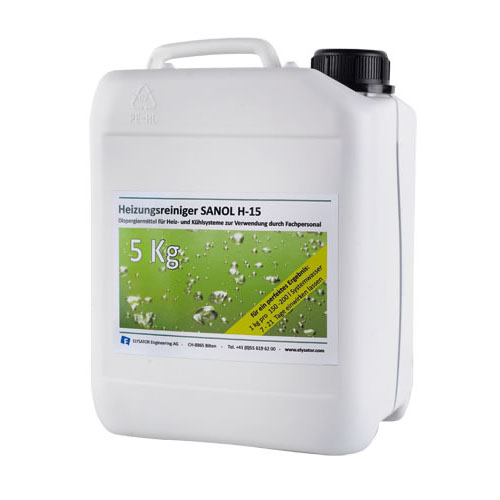Sanol H-15 - cleaning agent for heating systems and cooling systems
Each water system (heating, solar or cooling system) needs to be cleaned prior to final filling with treated water. This is especially true for older and refurbished systems. In this process, foreign materials (eg drawing greases, corrosion residue, solder, flux and welding agent) are removed from the system. However, even by a physical purging according to DIN 1988 (rinsing with speed, surge irrigation, reverse circulation, rinse with solid bodies) do not remove completely. Only the use of suitable cleaning agents (often based on fruit acids) reaches a residue-free removal of these substances.
The DIN EN 14336, still unheard by many professionals, provides that water systems must be rinsed. Unfortunately, the standard does not describe how that should be done. Most rinses are pointless, wasted time and even counterproductive, because the correct nominal width and arrangements of the rinse support a professional rinse is not permitted.
Plus, the cleaning agent must be removed completely, otherwise it can cause devastating effects to the treated filling water.
Sanol H-15 & data sheets
Clean the heating circuit in time
SANOL H-15 / SANOL H15 is exactly at this point and makes residue-free rinsing easier. Without such rinsing before using cleaned water, you will never remove all sludge accumulation and blockages in the heating circuit. Such investment in the safety and life span of a heating system would be unfortunately almost meaningless without basic cleaning. Although corrosion makes no small degree of damage potential for a heating system, but it is far from being the only source of damage.
Similar serious are sludge accumulations in heating circuits. The first signs of such are faults in the hydraulics of a heating system. This individual floor heating circuits, for example, are not getting warm enough. Nor can the thermostatic valves on the radiators and floor distributors serve no longer or only partially. As a result, the desired residential heat is no longer achieved.
If this progressive process is not countered, it will sooner or later indispensable lead to further damage. The next ordinary damages occur to the pump, mixing valves and heat exchangers. The corrosion particles located in the sludge accumulation scratch the metal interior surfaces repeatedly and thus produce more leaching by erosion. In particular, parts of soft metals such as copper and aluminum are particularly at risk. The amount of damage increases exponentially with the length and number of metal interior surfaces in a heating circuit.
Sludge accumulations also damage the central-heating boiler. Among the accumulating deposits it comes after some time to stress cracks in the material of the boiler. At these locations, the heating water evaporates repeatedly. The result are local corrosion attacks, gas formation and clearly audible, annoying noises.
SANOL H-15
At this point Sanol H-15 is to be used at the latest. It finds a remedy at an early stage and provides a basic cleaned heating system. With SANOL H-15, the cleaning work is safer and cheaper. SANOL H-15 is a novel, highly effective cleaning agent from the market leader Elysator. It surrounds the particles of loose and easily adhering sludges. Thus they become more buoyant and can be flushed very easily. SANOL H-15 has to act a few days to develop to the maximum effect.
Unlike conventional detergents, SANOL H-15 is suitable for any system water quality and is completely safe for all system components. With its excellent complexing and dispersing action, SANOL H-15 removes all loose and slightly adherent deposits in heating and cooling systems. Including magnetite and rust sludge, construction dirt and remnants of conditioning chemicals. SANOL H-15 is compatible with all commonly used materials in heating and cooling systems as alloyed and unalloyed steels, cast metals, nonferrous metals, rubber and plastics.
SANOL H-15 can be added undiluted to the system water, 6 kg for 1,000 liters of water are sufficient.
High circulation rates and temperatures increase the effect of the product.
The necessary exposure time is at least 7 days. The product may be kept longer in the system.
During the exposure, all control valves the heating system must be open in, so that the product can be distributed in all parts of the plant. Afterwards, every individual heating circuit, radiator, convector etc. has to be rinsed with fresh water by opening and closing the valves. The central-heating boiler, heating water storages and any other pipeline need to be cleaned.
data sheet SANOL H-15
SANOL H-15 is a mild cleanser that is used to remove iron oxide mud and tying of residues of chemical inhibitors in water systems.
- Mode of operation: SANOL H-15 removes iron oxide slurries, light iron oxide deposits and bonded thereto residues of chemical additives, which provides excellent complexing and dispersing properties
- Practice: SANOL H-15 may be used with presence of usual materials by back chill arrangements, heat exchangers, ground heatings and conduits. With longer effect time galvanised parts can be easily attacked.
- Qualities: H-15 SANOL is a clear, dark brown liquid with ammoniac smell.
- Poisonous category: is not subject to the poison legislation
- concentration: 1.2 g / ml
- pH value: 9.5
- Solidification point: 0 °C
- Handling/Safety/Storage: Skin and eye contact should be avoided. When handling SANOL H-15 rubber gloves and safety goggles must be worn. Protect from frost. Do not mix the concentrate with acids or strong oxidizing agents.
- Application instructions: SANOL H-15 is generally used as a 0.6% aqueous solution (approx. 6 kg of SANOL H-15 on 1000 l of water). High circulating rates and temperatures increase the effect of the product.
- Required exposure time: From 7 to 21 days
- Cleansing temperature: From 15 to 90 °C
- German Institute for Standardization EN 14336 „heating systems in buildings – installation and acceptance of the hot-water heating systems; German version, 01-2005
- 5.5 Rinsing and cleaning of the arrangement
The heating system must be rinsed. A recommended method is to be found in appendix C
Remark: The cleaning can be also carried out chemically (exception). A recommended method is also included in appendix C
It should be remembered whether the arrangement should be in a filled or unfilled condition when it is out of order.
- C.2.2 chemical cleaning
If a chemical cleaning is required, the following procedure is recommended:
- a) chemical cleaning should be carried out by rinsing with certified products;
- b) the system has to be completely rinsed and filled with water or without inhibitor, according to the requirements applicable for the facility;
- c) if the whole system is not chemically cleaned at the same time, it is recommended to close the security stop valves in order to avoid that contaminates can originate from non-treated system parts.



